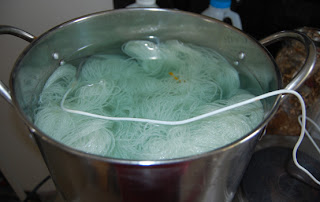I use copper, iron, alum and tin for mordanting.
The alum I use is the same kind that you get in the seasonings aisle at the grocery store. I buy it in bulk because it is more economical that way.
Copper took me a while find. Finally found it at Home Depot. It is used to kill roots in your sewer lines by putting it down the toilet.
Iron I ordered a pound of it from Earth Guild. http://www.earthguild.com/level2/products.htm
Tin I ordered from Aurora Silk when I ordered my Logwood.
Here is step by step of mrodanting. The method is the same for all four mordants. I have also included a chart of what percentage I use and any assistants as well.
1. Wet out the fiber.
2. Boil water for dissolving your mordant and assist.
3. Weigh your mordant and assist.
4. Dissolve your mordant in the boiling water.
5. Pour the dissolved mordant into the pot with the wet out fiber.
6. Heat the fiber slowly, over the course of an hour or more to 185F. I use a thermometer that is designed to do meat in the oven. I set if for chicken and set the alarm. This way I don't forget that I was mordanting.
The pot is ready to go.
7. After is has reached 185F, turn the heat down just a little and let it simmer for 1 hour. Then turn the heat off and leave until cool. Some people rinse the yarn and others don't. I do not have enough experience to say one way or another. I did rise my yarn for the logwood, cochineal and rhubarb in previous posts.
Here is the pot of copper after it has cooled.
Here are copper and alum hanging out to dry. These were not rinsed after mordanting. They are for future use.
The percentages used are based on the yarn weight. So if for example you have 100g of fiber to mordant, you would use 25g of alum and 8g cream of tartar.
mordant assist
alum 25% cream of tartar 8%
copper 4% vinegar 5%
tin 1% cream of tartar 2%
iron 2%



















